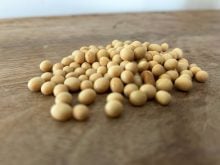Canola futures closed up about one percent Friday on concerns that the crop might prove smaller than expected and with light support from soybeans.
Reports have begun to surface that the oil content of early harvested canola is lower than the norm. Yields have also suffered from disease and July heat.
November canola closed at $633.60, up $6.80 (+1.08%).
From the close last Friday, it gained $25.50 per tonne.
The Canadian Oilseed Processors Association said members crushed 97,176 tonnes of canola in the week ending Aug. 22, down about 21 percent from the week before. That represented a capacity use of only 58 percent.
Read Also

ICE Weekly: Trade progress, new data threaten to break canola’s price range
Canola futures could be affected by trade progress between Canada and China as well as the USDA’s November supply and demand estimates.
• Rain is developing in Alberta and is heading into Saskatchewan today and Saturday before moving on to Manitoba. The North Battleford region is expected to get the largest accumulations with 30 to 40 mm, which could hurt quality. Luckily, dry warm weather is forecast to return Sunday and next week.
•Soybeans were higher overnight, gave back some of the gains this morning but closed in positive territory. Support came from weekly U.S. export sales that were higher than expected, indicating current prices are not yet high enough to ration demand.
•Corn was down slightly despite results from ProFarmer’s Midwest crop tour.
• The tour today pegged U.S. corn production at 10.478 billion bushels, based on a yield of 120.25 bu. per acre. That is less than the current USDA forecast of 10.779 billion bu. on a yield of 123.4 bu.
Today’s lower price indicates that traders had already priced in a crop smaller than USDA’s forecast.
• ProFarmer put the soybean crop at 2.60 billion bu., on a yield of 34.8 bu. per acre. USDA’s forecast is 2.692 billion bu. on yield of 36.1 bu. per acre. Pro Farmer crop scouts surveyed more than 2,200 corn and soybean fields in Midwest states that accounted for 73 percent of U.S. corn production in 2011 and 66 percent of soybean production.
• Wheat was weaker today, pressured lower by rain in the U.S. hard red winter wheat region, which has been suffering drought. Farmers there will start to seed winter wheat in September.
Losses were limited by dry weather in Australia’s wheat growing areas, particularly Western Australia. Serious yield losses are possible if the state does not get significant rain in September.
Winnipeg (per tonne)
Canola Nov 12 $633.60, up $6.80 +1.08%
Canola Jan 13 $637.20, up $7.20 +1.14%
Canola Mar 13 $635.30, up $6.80 +1.08%
Canola May 13 $620.80, up $6.20 +1.01%
Milling Wheat Oct 12 $294.20, down $2.00 -0.68%
Milling Wheat Dec 12 $301.20, down $2.00 -0.66%
Milling Wheat Mar 13 $311.20, down $2.00 -0.64%
Durum Wheat Oct 12 $301.10, unchanged
Durum Wheat Dec 12 $305.60, unchanged
Durum Wheat Mar 13 $312.20, unchanged
Barley Oct 12 $264.50, unchanged
Barley Dec 12 $269.50, unchanged
Barley Mar 13 $272.50, unchanged
Chicago (per bushel)
Soybeans (P) Sep 12 $17.375, up 10.25 cents +0.59%
Soybeans Nov 12 17.315, up 16.5 +0.96%
Soybeans (P) Jan 13 $17.2425, up 18.25 +1.07%
Soybeans (P) Mar 13 $16.3625, up 21.75 +1.35%
Corn (P) Sep 12 $8.0225, down 6.5 -0.80%
Corn (P) Dec 12 $8.085, down 6.25 -0.77%
Corn (P) Mar 13 $8.085, down 5.75 -0.71%
Oats (P) Sep 12 $3.885, up 1.0 +0.26%
Oats (P) Dec 12 $3.915, up 0.5 +0.13%
Oats (P) Mar 13 $3.92, unchanged
Minneapolis (per bushel)
Spring Wheat Sep 12 $9.185, down 2.0 cents -0.22%
Spring Wheat Dec 12 $9.30, down 4.25 -0.45%
Spring Wheat Mar 13 $9.385, down 4.75 -0.50%
Spring Wheat May 13 $9.4525, down 3.75 -0.40%
Nearby crude oil futures in New York closed down 12 cents at 96.15 per barrel.
The Bank of Canada’s noon rate for the loonie was $1.0081 US, up from $1.0073 the previous day.
The U.S. dollar was 99.20 cents Cdn.
Stock markets were mostly up Friday on news that the European Central Bank is considering a policy to intervene in the bond market to lower the cost of borrowing for Spain and Greece.
Because of their severe debt problems, when those two countries go to the bond market to cover borrowing needs they must pay a costly high interest rate, called the yield, to get buyers’ interest. The ECB’s plan would result in lower borrowing costs for Spain, Greece and other high debt EU countries.
In early tallies:
The Toronto Stock Exchange’s S&P/TSX composite index closed up 19.72 points, or 0.16 percent, at 12,082.23.
The Dow Jones industrial average shot up 100.51 points, or 0.77 percent, to end at 13,157.97.
The Standard & Poor’s 500 Index rose 9.04 points, or 0.64 percent, to close at 1,411.12.
The Nasdaq Composite Index gained 16.39 points, or 0.54 percent, to close at 3,069.79.
For the week, The TSX was virtually unchanged, the Dow fell 0.9 percent, the S&P 500 slipped 0.5 percent and the Nasdaq dipped 0.2 percent.
Follow me on Twitter @darcemcmillan














